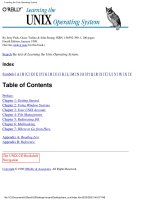o'reilly - kerberos the definitive guide
Bạn đang xem bản rút gọn của tài liệu. Xem và tải ngay bản đầy đủ của tài liệu tại đây (3.06 MB, 131 trang )
Contents
1. Unknown
2. Unknown
3. Unknown
4. Unknown
5. Unknown
6. Unknown
7. Unknown
8. Unknown
9. Unknown
10. Unknown
11. Unknown
12. Unknown
13. Unknown
14. Unknown
15. Unknown
16. Unknown
17. Unknown
18. Unknown
19. Unknown
20. Unknown
21. Unknown
22. Unknown
23. Unknown
24. Unknown
25. Unknown
26. Unknown
27. Unknown
28. Unknown
29. Unknown
30. Unknown
31. Unknown
32. Unknown
33. Unknown
34. Unknown
35. Unknown
36. Unknown
37. Unknown
38. Unknown
39. Unknown
40. Unknown
41. Unknown
42. Unknown
43. Unknown
44. Unknown
45. Unknown
46. Unknown
47. Unknown
48. Unknown
49. Unknown
50. Unknown
51. Unknown
52. Unknown
53. Unknown
54. Unknown
55. Unknown
56. Unknown
57. Unknown
58. Unknown
59. Unknown
60. Unknown
61. Unknown
62. Unknown
63. Unknown
64. Unknown
65. Unknown
66. Unknown
67. Unknown
68. Unknown
69. Unknown
70. Unknown
71. Unknown
72. Unknown
73. Unknown
74. Unknown
75. Unknown
76. Unknown
77. Unknown
78. Unknown
79. Unknown
80. Unknown
81. Unknown
82. Unknown
83. Unknown
84. Unknown
85. Unknown
86. Unknown
87. Unknown
88. Unknown
89. Unknown
90. Unknown
91. Unknown
92. Unknown
93. Unknown
94. Unknown
95. Unknown
96. Unknown
97. Unknown
98. Unknown
99. Unknown
100. Unknown
[ Team LiB ]
Table of Contents
Index
Reviews
Reader Reviews
Errata
Kerberos: The Definitive Guide
By Jason Garman
Publisher: O'Reilly
Pub Date: August 2003
ISBN: 0-596-00403-6
Pages: 272
Single sign-on is the holy grail of network administration, and Kerberos is the only game in town.
Microsoft, by integrating Kerberos into Active Directory in Windows 2000 and 2003, has extended the
reach of Kerberos to all networks large or small. Kerberos: The Definitive Guide shows you how to
implement Kerberos on Windows and Unix systems for secure authentication. In addition to covering
the basic principles behind cryptographic authentication, it covers everything from basic installation to
advanced topics like cross-realm authentication, defending against attacks on Kerberos, and
troubleshooting.
[ Team LiB ]
[ Team LiB ]
Table of Contents
Index
Reviews
Reader Reviews
Errata
Kerberos: The Definitive Guide
By Jason Garman
Publisher: O'Reilly
Pub Date: August 2003
ISBN: 0-596-00403-6
Pages: 272
Dedication
Copyright
Preface
Organization of This Book
Conventions Used in This Book
Comments and Questions
Thanks
Chapter 1. Introduction
Section 1.1. Origins
Section 1.2. What Is Kerberos?
Section 1.3. Goals
Section 1.4. Evolution
Section 1.5. Other Products
Chapter 2. Pieces of the Puzzle
Section 2.1. The Three As
Section 2.2. Directories
Section 2.3. Privacy and Integrity
Section 2.4. Kerberos Terminology and Concepts
Section 2.5. Putting the Pieces Together
Chapter 3. Protocols
Section 3.1. The Needham-Schroeder Protocol
Section 3.2. Kerberos 4
Section 3.3. Kerberos 5
Section 3.4. The Alphabet Soup of Kerberos-Related Protocols
Chapter 4. Implementation
Section 4.1. The Basic Steps
Section 4.2. Planning Your Installation
Section 4.3. Before You Begin
Section 4.4. KDC Installation
Section 4.5. DNS and Kerberos
Section 4.6. Client and Application Server Installation
Chapter 5. Troubleshooting
Section 5.1. A Quick Decision Tree
Section 5.2. Debugging Tools
Section 5.3. Errors and Solutions
Chapter 6. Security
Section 6.1. Kerberos Attacks
Section 6.2. Protocol Security Issues
Section 6.3. Security Solutions
Section 6.4. Protecting Your KDC
Section 6.5. Firewalls, NAT, and Kerberos
Section 6.6. Auditing
Chapter 7. Applications
Section 7.1. What Does Kerberos Support Mean?
Section 7.2. Services and Keytabs
Section 7.3. Transparent Kerberos Login with PAM
Section 7.4. Mac OS X and the Login Window
Section 7.5. Kerberos and Web-Based Applications
Section 7.6. The Simple Authentication and Security Layer (SASL)
Section 7.7. Kerberos-Enabled Server Packages
Section 7.8. Kerberos-Enabled Client Packages
Section 7.9. More Kerberos-Enabled Packages
Chapter 8. Advanced Topics
Section 8.1. Cross-Realm Authentication
Section 8.2. Using Kerberos 4 Services with Kerberos 5
Section 8.3. Windows Issues
Section 8.4. Windows and Unix Interoperability
Chapter 9. Case Study
Section 9.1. The Organization
Section 9.2. Planning
Section 9.3. Implementation
Chapter 10. Kerberos Futures
Section 10.1. Public Key Extensions
Section 10.2. Smart Cards
Section 10.3. Better Encryption
Section 10.4. Kerberos Referrals
Section 10.5. Web Services
Appendix A. Administration Reference
Section A.1. MIT
Section A.2. Configuration File Format
Colophon
Index
[ Team LiB ]
[ Team LiB ]
Dedication
Dedicated in loving memory to my grandfather, Harry Stumpff.
—Jason Garman
[ Team LiB ]
[ Team LiB ]
Copyright
Copyright 2003 O'Reilly & Associates, Inc.
Printed in the United States of America.
Published by O'Reilly & Associates, Inc., 1005 Gravenstein Highway North, Sebastopol, CA 95472.
O'Reilly & Associates books may be purchased for educational, business, or sales promotional use.
Online editions are also available for most titles (). For more information, contact
our corporate/institutional sales department: (800) 998-9938 or
Nutshell Handbook, the Nutshell Handbook logo, and the O'Reilly logo are registered trademarks of
O'Reilly & Associates, Inc. Many of the designations used by manufacturers and sellers to distinguish
their products are claimed as trademarks. Where those designations appear in this book, and O'Reilly &
Associates, Inc. was aware of a trademark claim, the designations have been printed in caps or initial
caps. The association between the image of a barred owl and the topic of Kerberos is a trademark of
O'Reilly & Associates, Inc.
While every precaution has been taken in the preparation of this book, the publisher and author assume
no responsibility for errors or omissions, or for damages resulting from the use of the information
contained herein.
[ Team LiB ]
[ Team LiB ]
Preface
Kerberos is a sophisticated network authentication system—one that has been publicly available since
1989 and provides that eternal holy grail of network administrators, single-sign-on. Yet, in that
intervening decade, documentation on Kerberos has been notably lacking. While many large
organizations and academic institutions have enjoyed the benefits of using Kerberos in their networks,
the deployment of Kerberos in smaller networks has been severely hampered by a lack of
documentation.
I decided to write this book precisely because of this lack of useful documentation. My own experiences
with Kerberos are those of extreme frustration as I attempted to decipher the documentation. I found
that I had to keep copious notes to keep everything straight. Those notes eventually became the outline
of this book.
Today, Microsoft, through its adoption of the latest Kerberos protocol as the preferred authentication
mechanism in its Active Directory, has single-handedly driven the use of Kerberos into the majority of
the operating-system market that it controls. Thanks to the openness of Kerberos, organizations now
can establish cross-platform, single sign-on network environments, giving an end-user one set of
credentials that will provide him access to all network resources, regardless of platform or operating
system. Yet the workings and benefits of Kerberos remain a mystery to most network administrators.
This book aims to pull away the curtain and reveal the magician working behind the scenes.
This book is geared toward the system administrator who wants to establish a single sign-on network
using Kerberos. This book is also useful for anyone interested in how Kerberos performs its magic: the
first three chapters will be most helpful to these people.
[ Team LiB ]
[ Team LiB ]
Organization of This Book
Here's a breakdown of how this book is organized:
Chapter 1
Provides a gentle introduction to Kerberos, and provides an overview of its history and features. It
provides a gentle prologue by bringing you from the reasons for the development of Kerberos at MIT
through to the latest versions of the protocol.
Chapter 2
Continues where Chapter 1 left off, presenting an introduction to the concepts and terminology that
permeate the use and administration of Kerberos. The knowledge of these concepts is essential to the
understanding of how Kerberos works as well as how to use and administer it.
Chapter 3
Speaking of how Kerberos works, Chapter 3 reviews the Kerberos protocol via a historical perspective
that takes you through the evolution of Kerberos from an academic paper published in 1978 to the
modern Kerberos 5 protocol used today. Chapter 3 provides a detailed yet easy-to-follow description
of how the Kerberos protocol works and describes the numerous encrypted messages that are sent
back and forth.
Chapter 4
Takes you from the realm of the theoretical and conceptual into the practical aspects involved in
administering a Kerberos system. Here, the Kerberos implementations that will be discussed throughout
the book are introduced, and the basics of the installation and administration of a Kerberos
authentication system are described.
Chapter 5
When things go wrong with your Kerberos implementation, Chapter 5 will come in handy. Chapter 5
provides a methodology for diagnosing Kerberos-related problems and demonstrates some of the more
common errors that can occur.
Chapter 6
Provides a detailed look at the practical security concerns related to running Kerberos.
Chapter 7
Reviews some common software that can be configured to use Kerberos authentication.
Chapter 8
Provides information about more advanced topics in running a Kerberos authentication system, including
how to interoperate between Unix and Windows Kerberos implementations. This chapter also reviews
how multiple Kerberos realms can cooperate and share resources through cross-realm authentication.
Chapter 9
Presents a sample case study that demonstrates the implementation tasks presented earlier in a practical
example.
Chapter 10
Finishes off the book with a description of the future directions Kerberos is taking. We'll examine new
protocol enhancements that will enable Kerberos to take advantage of new security and encryption
[ Team LiB ]
[ Team LiB ]
Conventions Used in This Book
The following conventions are used in this book.
Italic
Used for file and directory names and for URLs. It is also used to emphasize new terms and concepts
when they are introduced.
Constant Width
Used for code examples, commands, options, variables, and parameters.
Constant Width Italic
Indicates a replaceable term in code.
Indicates a tip, suggestion, or general note.
Indicates a warning.
[ Team LiB ]
[ Team LiB ]
Comments and Questions
We have tested and verified all of the information in this book to the best of our ability, but you may find
that features have changed, that typos have crept in, or that we have made a mistake. Please let us know
about what you find, as well as your suggestions for future editions, by contacting:
O'Reilly & Associates, Inc. 1005 Gravenstein Highway NorthSebastopol, CA 95472 (800)998-9938
(in the U.S. or Canada) (707)829-0515 (international/local) (707)829-0104 (fax)
You can also send us messages electronically. To be put on the mailing list or request a catalog, send
email to:
To ask technical questions or comment on the book, send email to:
We have a web site for the book, where we'll list examples, errata, and any plans for future editions.
You can access this page at:
For more information about this book and others, see the O'Reilly web site:
[ Team LiB ]
[ Team LiB ]
Thanks
First, I'd like to thank my editor at O'Reilly, Michael Loukides, without whom this book would not exist.
His encouragement and direction (along with his seemingly infinite patience) allowed me to finish this
book while sustaining only minor injuries.
There were many people who took the time to review this text and suggest valuable changes. These
people, in no particular order, include Mike Lonergan, Ken Hornstein, Frank Balluffi, Robbie Allen,
Mohammad Haque, and Marcus Miller. Their constructive criticism of my early drafts helped to make
this book as complete and technically accurate as possible.
I'd also like to thank the friends and co-workers who have provided support and entertainment during
this process. Brian Dykstra, Brad Johnson, Mark Yu, Nan Ting, Keith Jones, and many others helped
me finish this project through their encouragement over this past year.
And last but not least, I'd like to thank my parents, Arthur and Mary Garman, who encouraged me to
explore my interest in computers and provided me with the Commodore 64 that sparked my imagination.
[ Team LiB ]
[ Team LiB ]
Chapter 1. Introduction
Who are you? It's a question with an obvious response, at least for people. Humans have the ability to
distinguish one another through several senses; most commonly, we use our sense of vision to recognize
people we have met before. We also can tell one another apart through other means, such as body
language, speech patterns and accents, and shared secrets between people. It has even been shown that
newborn babies can discern between their mother and other females solely through their scent. Our
ability to recognize patterns in our surroundings provides us with this ability to determine the identity of,
or authenticate, people we know.
However, when you bring a computer into the picture, the situation changes dramatically. Computers (at
least today's computers) don't have eyes, ears, or noses. Even if they did, the current state-of-the-art in
pattern recognition is still woefully inaccurate for widespread use. While there is a lot of research in this
area, the most common method by far for authenticating people to computers is through passwords. A
password, also known as a shared secret, is the one critical piece of information that determines
whether the person behind the keyboard really is whom they claim to be. While humans sometimes use
this shared secret method—for example, a secret handshake, or perhaps the knowledge of obscure
trivia—computers almost exclusively use shared secrets to authenticate people.
There are two issues with passwords as used today for authentication. The first is a human problem. We
don't like to remember a long, complex string of numbers, letters, and maybe even symbols that make up
a secure password. If left to our own devices, we use simple dictionary words or maybe even our
spouses' name or birthdate as passwords. Unfortunately, a "shared secret" that really isn't a secret (such
as your spouse's name) is easily guessable by an attacker who wishes to impersonate you to the
computer. This problem is exacerbated by the fact that, even within a company network, there are
literally dozens of machines a person has access to, each of which requires its own password. As a
general rule, as the number of passwords goes up, the quality of each password decreases.
The second issue is a technical problem. While the computer gives you the illusion of security by printing
stars, or nothing at all, on the screen while you type your password, somehow that information must
travel some communications network to a computer on the other end. The most common method that
computers use to send passwords over the network is by sending the password in "clear text," that is,
unmodified. While this wouldn't be a problem if each computer had a completely separate, dedicated
connection to every other computer it wishes to communicate with, in reality, computer networks are a
shared resource. Sending passwords over the network in the clear is analogous to standing in a crowded
room shouting across the room to a friend standing on the other side.
Kerberos is a network authentication system that can help solve those two issues. It reduces the number
of passwords each user has to memorize to use an entire network to one—the Kerberos password. In
addition, Kerberos incorporates encryption and message integrity to solve the second issue, ensuring
that sensitive authentication data is never sent over the network in the clear. By providing a secure
authentication mechanism, Kerberos is an essential part of a total network security plan, providing clear
benefits for both end users and administrators.
[ Team LiB ]
[ Team LiB ]
1.1 Origins
The word Kerberos originates from Greek mythology, which contains the legend of Cerberus. Cerberus
guarded the realm of the underworld, ruled by Hades and his wife, Persephone. What Cerberus looked
like depends on whom you ask; Hesiod claims that Cerberus has fifty heads, while Apollodorus
describes him as a strange mixture of creatures with three dog-shaped heads, a serpent as a tail, and
heads of snakes over his back. Cerberus is most often pictured as a creature with three heads. Either
way, Cerberus was a vicious creature that few dared to challenge.
The Greeks believed that when a person dies, his soul is sent to Hades to spend eternity. While all souls
were sent to Hades, those people who had led a good life would be spared the eternal punishment that
those who had not would have to endure. Cerberus, as the gatekeeper to Hades, ensured that only the
souls of the dead entered Hades, and he ensured that souls could not escape once inside.
As the gatekeeper to Hades, Cerberus authenticated those who attempted to enter (to determine
whether they were dead or alive) and used that authentication to determine whether to allow access or
not. Just like the ancient Cerberus, the modern Kerberos authenticates those users who attempt to
access network resources.
Like every other great figure in mythology, Cerberus had a fatal flaw that enabled some clever people to
pass through Cerberus to Hades. We'll revisit the legend and discuss one such story and its modern
counterparts in Chapter 6.
Finally, if the ancient mythological character was named Cerberus, why is the modern authentication
system called Kerberos? Simply put, they are just different spellings of the same word. In order to
provide a distinction between the ancient mythology and the present-day software system, we will refer
to the mythological character as Cerberus and the modern software system as Kerberos.
1.1.1 Modern History
The modern-day origins of the Kerberos network authentication system are a bit more mundane than the
ancient mythology of Cerberus. Kerberos began as a research project at the Massachusetts Institute for
Technology (MIT) in the early 1980s. The MIT faculty at the time recognized that the explosion of
widely available, inexpensive computers would transform the computing industry.
1.1.1.1 The time-sharing model
Traditionally, computers were a large, expensive, and centralized resource that end users accessed
through dumb terminals connected via serial lines. This is called the time-sharing model (Figure 1-1).
Figure 1-1. Time-sharing model
[ Team LiB ]
[ Team LiB ]
1.2 What Is Kerberos?
The full definition of what Kerberos provides is a secure, single-sign-on, trusted, third-party mutual
authentication service. What does that mean? Let's break that definition down into its parts and quickly
describe each one.
Secure
Kerberos is secure since it never transmits passwords over the network in the clear. Kerberos is unique
in its use of tickets, time-limited cryptographic messages that prove a user's identity to a given server
without sending passwords over the network or caching passwords on the local user's hard disk.
Single-sign-on
Single-sign-on means that end users only need to log in once to access all network resources that
support Kerberos. Once a user has authenticated to Kerberos at the start of her login session, her
credentials are transparently passed to every other resource she accesses during the day.
Trusted third-party
Trusted third-party refers to the fact that Kerberos works through a centralized authentication server
that all systems in the network inherently trust. All authentication requests are routed through the
centralized Kerberos server.
Mutual authentication
Mutual authentication ensures that not only is the person behind the keyboard who he claims to be,
but also proves that the server he is communicating with is who it claims to be. Mutual authentication
protects the confidentiality of sensitive information by ensuring that the service the user is communicating
with is genuine.
These three concepts describe the basis of the Kerberos network authentication service. We'll take a
closer look at these concepts and the surrounding terminology in the following chapter.
[ Team LiB ]
[ Team LiB ]
1.3 Goals
The Kerberos system has several goals. It strives to improve security and convenience at the same time.
First is the goal of centralizing authentication into one server (or set of servers). The Kerberos system
operates through a set of centralized Key Distribution Centers, or KDCs. Each KDC on your network
contains a database of usernames and passwords for both users and Kerberos-enabled services.
Centralizing this information eases the burden on administrators, as they now only need to maintain this
single username/password database. In addition, it provides an advantage to security administrators,
who now only have a small set of machines on which usernames and passwords are stored, and can
specially harden and protect these machines accordingly.
Kerberos provides a secure means of authentication over insecure networks. Instead of sending
plain-text passwords over the network in the clear, Kerberos uses encrypted tickets to prove the
identity of both end users and network servers. These tickets are generated by the centralized Key
Distribution Centers on behalf of users who wish to authenticate to the network. When using Kerberos,
user passwords are never sent over the network in the clear.
In addition, implementing the other two elements of the "three A's" (authorization and
auditing—authentication, of course, is the third A) are made easier using Kerberos. While Kerberos
does not directly provide authorization or auditing services, Kerberos' ability to accurately identify both
users and services allows programmers and administrators to provide authorization and auditing to
further enhance the security of their network. We'll talk more about what exactly authorization and
auditing are in the next chapter.
[ Team LiB ]
[ Team LiB ]
1.4 Evolution
The modern Kerberos protocol has gone through several major revisions since it was first conceived as
part of Project Athena. During each revision, major improvements have been made in usability,
extensibility, and security.
1.4.1 Early Kerberos (v1, v2, v3)
The early versions of Kerberos (pre-Version 4) were created and used internally at MIT for testing
purposes. These implementations contained significant limitations and were only useful to examine new
ideas and observe the practical issues that arose during development and testing.
1.4.2 Kerberos 4
The first version of Kerberos distributed outside of MIT was Kerberos 4. First released to the public on
January 24, 1989, Kerberos 4 was adopted by several vendors, who included it in their operating
systems. In addition, other, large distributed software projects such as the Andrew File System adopted
the concepts behind Kerberos 4 for their own authentication mechanisms.
The basics of what was to become the Kerberos 4 protocol are documented in the Athena Technical
Plan. Ultimately, the details of the protocol were documented through the source code in the reference
implementation published by MIT.
However, due to export control restrictions on encryption software imposed by the U.S. government,
Kerberos 4 could not be exported outside of the United States. Since Kerberos 4 uses DES encryption,
organizations outside of the U.S. could not legally download the Kerberos 4 software as-is from MIT.
In response, the MIT development team stripped all of the encryption code from Kerberos 4 to create a
specialized, exportable version. Errol Young, at Bond University of Australia, took this stripped version
of Kerberos 4 and added his own implementation of DES to create "eBones." Since eBones contained
encryption software developed outside of the United States, it was unencumbered by the U.S.
encryption export controls, and could be legally used anywhere in the world.
Today, several implementations of Kerberos 4 still exist. The original MIT Kerberos 4 implementation is
now in a maintenance mode and officially considered "dead." The kth-krb distribution, developed in
Sweden, is still actively developed but it is highly recommended that new installations use the superior
Kerberos 5 instead. In this book, coverage of Kerberos 4 is restricted to a discussion of the protocol in
Chapter 3. Most of the book covers the next version of Kerberos, Kerberos 5.
1.4.3 Kerberos 5
Kerberos 5 was developed to add features and security enhancements that were not present in Version
4 of the protocol. Kerberos 5 is the latest version of the Kerberos protocol and is documented in RFC
1510.
[ Team LiB ]
[ Team LiB ]
1.5 Other Products
Many other products have been developed that either directly implement the Kerberos protocols or
borrow concepts from Kerberos to implement similar authentication systems. We'll take a brief look at
these alternative systems, and discuss the relationship between these systems and Kerberos.
1.5.1 DCE
The Distributed Computing Environment, or DCE, is a set of libraries and services that enable
organizations to build cross-platform, integrated computing environments. It includes components that
enable applications to communicate across a diverse set of platforms and securely locate and access
information, whether it's in the same room on a local network or across the globe over the Internet. DCE
provides many services to make this possible, including directory services, remote procedure calls, and
time-synchronization. Most notable to our discussion, it provides a security service, which just happens
to be based on Kerberos 5.
Work on DCE began in 1989, and was developed through a committee of vendors who have submitted
various bits and pieces. The work was coordinated by The Open Group, an organization that is most
widely known for the Motif widget set. Unfortunately, while the concepts that underlie DCE were
revolutionary and ahead of their time, DCE was difficult to install and administer, and early versions were
riddled with bugs. Today, DCE itself is not in wide use, but the concepts behind it have been integrated
in most modern operating systems today, including Windows 2000 and above.
In 1997, The Open Group released the source code to the latest version of DCE, 1.2.2, to download
for free from their web site. More information on DCE, including information on how to download Free
DCE, can be found at />
1.5.2 Globus Security Infrastructure
The Globus Security Infrastructure is part of a larger project, the Globus Toolkit. The goal of the Globus
Toolkit is to develop services that enable grid computing, also known as High Performance Computing
(HPC) or compute clusters. Globus includes services to locate people and resources on the network, as
well as submit and control compute jobs running on machines in the network. In order to perform its
tasks securely, however, it needed a secure authentication and privacy mechanism. The Globus Security
Infrastructure, or GSI, is the Globus Toolkit's implementation of a secure authentication system.
While the GSI operates under different principles than Kerberos, most notably through its use of public
key encryption and infrastructure, it provides the same single-sign-on user experience that Kerberos
does. In addition, the developers of Globus recognized the need for interoperability with existing
Kerberos installations, so the Globus team has developed several tools that allow interoperability
between Kerberos tickets and Globus certificates.
More information is available about the Globus Toolkit at />
[ Team LiB ]
[ Team LiB ]
Chapter 2. Pieces of the Puzzle
In the previous chapter, we examined the ideas and history behind the Kerberos network authentication
system. Now we'll begin to discover how Kerberos works. Instead of introducing these concepts as
they're needed in the next chapter, I feel that it is easier to understand the nitty-gritty details of Kerberos
when you have a working background in the surrounding terminology. To emphasize the importance of a
solid understanding in these concepts, I have set aside this chapter to introduce you to the essential
concepts and terminology that surround the use and administration of a Kerberos authentication system.
While you may be familiar with some of these concepts, we're going to examine each one in turn and
describe how it relates to Kerberos.
Kerberos is a complex system, with many parts. It requires the proper functioning of many separate
software components, and with each comes a set of terms and concepts that underlie the entire system.
A complete introduction to all of these concepts is critical to the understanding of the whole.
After all of these terms have been introduced, we'll finish off by putting all of the pieces together and set
the stage for the detailed description of the Kerberos protocols in Chapter 3. For those who simply wish
to implement a Kerberos realm and not worry about the low-level details of the protocol, this chapter
will prepare you to skip directly to Chapter 4.
[ Team LiB ]
[ Team LiB ]
2.1 The Three As
We'll start out our discussion with a topic that many network professionals deal with on a daily basis, the
three As. Authentication, authorization, and auditing are a crucial part of any network security scheme,
yet the distinction between them is often unclear. Each one of these components serves a separate,
distinct purpose in a network security scheme. In particular, we will focus on authentication and
authorization, and how they relate to each other.
2.1.1 Authentication
Simply put, authentication is the process of verifying the identity of a particular user. To authenticate a
user, the user is asked for information that would prove his identity. This information can fall into one or
more of three categories: what he knows, what he has, or what he is. These categories are referred to as
factors.
The first factor, what he knows, is the most common factor used in authentication today. A secret
password is generated when the user is granted access to a machine or network. That secret can either
be generated by the user himself, by choosing his own password and giving it to the system administrator
when he grants the user access, or automatically through some process that generates random
passwords.
The second factor, what he has, is a less common but more secure alternative. An example of this type
of authentication is the widely deployed RSA SecurID token. The SecurID token is a small electronic
device that has an embedded encryption key and an LCD display. Every minute, an algorithm runs inside
the device and updates the LCD display with a new six-digit combination. Only the person who
possesses the device can tell what the correct password is. Other systems, such as smart card systems,
operate on similar principles.
The third factor, what he is, enters into the realm of biometrics. Since all humans have distinguishing
characteristics, biometrics measures the physical properties of some portion of our body and uses that
information to authenticate users. Current biometric systems include fingerprint scanning, retina scanning,
voiceprint recognition, and face recognition. Biometrics does not yet enjoy a wide market for several
reasons: products are still immature for widespread use, some are very expensive (such as retina
scanning), and, perhaps the most important reason of all, there is currently little software support for
these devices.
Of course, an authentication system can combine these factors. For example, the RSA SecurID login
process involves not only the SecurID token but also a numeric PIN. Therefore, SecurID combines the
first two factors, what you have and what you know. Obviously, a system that combines more than one
factor is more secure than a system which depends on only one.
The Kerberos protocol itself does not specify which authentication factors must be used. Although most
implementations use a password-based system, there are implementations, such as the one present in
Microsoft's Windows 2000 and above, which allow Kerberos login tied to the use smart cards. Smart
[ Team LiB ]
[ Team LiB ]
2.2 Directories
A common misconception surrounding Kerberos and other authentication technologies is that they
somehow replace directories, such as the Unix /etc/passwd file, NIS, NetInfo, or LDAP. Along the
same lines, another common misconception is that directories make good authentication systems by
themselves. Therefore, a distinction needs to be made between authentication, authorization, and
directories. For a real-life analogy of what roles each of these components play, see the sidebar
Confusing Authentication, Authorization, and Directories.
Directories contain data describing resources, such as computers, printers, and user accounts that are
contained within a particular network. Directories can be as simple as a text file, such as the /etc/passwd
and /etc/group files on traditional Unix systems, which list the active user accounts and their group
permissions. Or a directory can be a complex LDAP directory structure, such as Microsoft's Active
Directory.
Directories can contain authentication data. Authenticating "against" a directory takes two forms: a client
machine can contact a directory, obtain the hashed version of the user's password, hash the password
given by the user, and compare the two. This method is used by NIS, for example. The other form,
employed by most LDAP authentication mechanisms, is to attempt to bind to the LDAP directory using
the credentials that the user provided. If the user is granted access to the directory, the authentication is
successful. The pam_ldap PAM module uses this latter method to authenticate against an LDAP
directory.
Using Kerberos to handle authentication is superior to these methods for several reasons:
•
•
Using Kerberos tickets, users can be granted single-sign-on access to all network resources
without requiring the client machine to cache the user's password. Kerberos tickets are
cryptographic messages that are only valid for a relatively short period of time, typically 8-24
hours. The compromise of a user's password, on the other hand, provides an attacker the ability
to masquerade as the legitimate user for a much longer period of time—specifically, until the
password is changed or expires.
•
•
With Kerberos, the user's password is never sent in the clear over the network during the login
process.
•
•
Kerberos defines a widely adopted and standardized protocol that is suited for authentication.
Therefore, while a directory may contain authentication information (for example, Microsoft's Active
Directory stores the Kerberos database in its LDAP store), it is preferable to use Kerberos to perform
authentication rather than using the directory for authentication directly.
[ Team LiB ]
[ Team LiB ]









